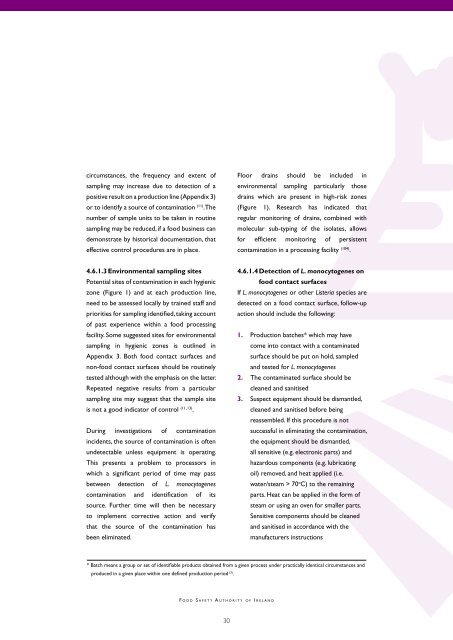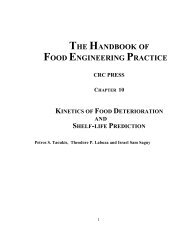Download - SMAS
Download - SMAS
Download - SMAS
- No tags were found...
Create successful ePaper yourself
Turn your PDF publications into a flip-book with our unique Google optimized e-Paper software.
circumstances, the frequency and extent ofsampling may increase due to detection of apositive result on a production line (Appendix 3)or to identify a source of contamination (11) . Thenumber of sample units to be taken in routinesampling may be reduced, if a food business candemonstrate by historical documentation, thateffective control procedures are in place.Floor drains should be included inenvironmental sampling particularly thosedrains which are present in high-risk zones(Figure 1). Research has indicated thatregular monitoring of drains, combined withmolecular sub-typing of the isolates, allowsfor efficient monitoring of persistentcontamination in a processing facility (104) .4.6.1.3 Environmental sampling sitesPotential sites of contamination in each hygieniczone (Figure 1) and at each production line,need to be assessed locally by trained staff andpriorities for sampling identified, taking accountof past experience within a food processingfacility. Some suggested sites for environmentalsampling in hygienic zones is outlined inAppendix 3. Both food contact surfaces andnon-food contact surfaces should be routinelytested although with the emphasis on the latter.Repeated negative results from a particularsampling site may suggest that the sample siteis not a good indicator of control (11, 13) .During investigations of contaminationincidents, the source of contamination is oftenundetectable unless equipment is operating.This presents a problem to processors inwhich a significant period of time may passbetween detection of L. monocytogenescontamination and identification of itssource. Further time will then be necessaryto implement corrective action and verifythat the source of the contamination hasbeen eliminated.4.6.1.4 Detection of L. monocytogenes onfood contact surfacesIf L. monocytogenes or other Listeria species aredetected on a food contact surface, follow-upaction should include the following:1. Production batches* which may havecome into contact with a contaminatedsurface should be put on hold, sampledand tested for L. monocytogenes2. The contaminated surface should becleaned and sanitised3. Suspect equipment should be dismantled,cleaned and sanitised before beingreassembled. If this procedure is notsuccessful in eliminating the contamination,the equipment should be dismantled,all sensitive (e.g. electronic parts) andhazardous components (e.g. lubricatingoil) removed, and heat applied (i.e.water/steam > 70 o C) to the remainingparts. Heat can be applied in the form ofsteam or using an oven for smaller parts.Sensitive components should be cleanedand sanitised in accordance with themanufacturers instructions* Batch means a group or set of identifiable products obtained from a given process under practically identical circumstances andproduced in a given place within one defined production period (3) .F O O D S A F E T Y A U T H O R I T Y O F I R E L A N D30














